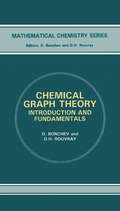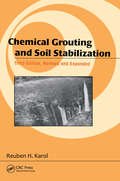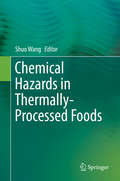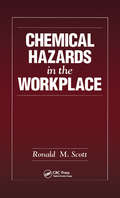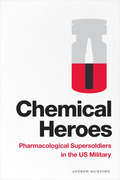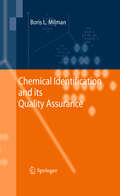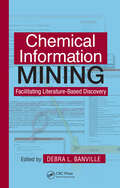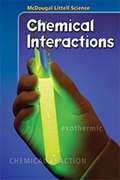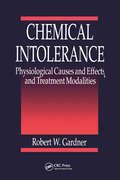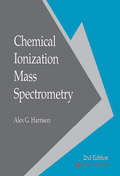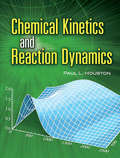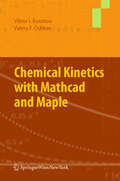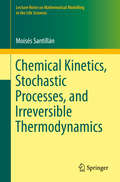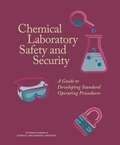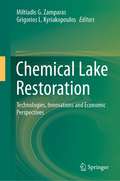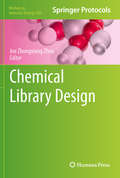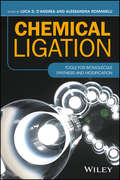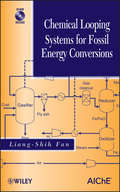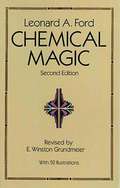- Table View
- List View
Chemical Graph Theory: Introduction and Fundamentals (Mathematical Chemistry Ser.)
by D BonchevThis volume presents the fundamentals of graph theory and then goes on to discuss specific chemical applications. Chapter 1 provides a historical setting for the current upsurge of interest in chemical graph theory. Chapter 2 gives a full background of the basic ideas and mathematical formalism of graph theory and includes such chemically relevant notions as connectedness, graph matrix representations, metric properties, symmetry and operations on graphs. This is followed by a discussion on chemical nomenclature and the trends in its rationalization by using graph theory, which has important implications for the storage and retrieval of chemical information. This volume also contains a detailed discussion of the relevance of graph-theoretical polynomials; it describes methodologies for the enumeration of isomers, incorporating the classical Polya method, as well as more recent approaches.
Chemical Grouting And Soil Stabilization, Revised And Expanded
by Reuben H. KarolFollowing shifting trends from remedial to preventive uses of grouting practices, this third edition covers all aspects of chemical grouting methods and applications. This reference highlights new ground improvement techniques as well as recent innovations in soil modification and stabilization procedures. It considers commercial alternatives to ground improvement, their relative advantages and disadvantages, and the engineering applications to which these methods are suited. Revised and expanded, this new edition assesses the role of new grouting techniques in the containment of hazardous waste and introduces numerous problems to illustrate concepts and facilitate instruction.
Chemical Hazards in Thermally-Processed Foods
by Shuo WangThis book summarizes the types, contents, analytical methods, formation mechanisms and control strategies for hazardous substances produced during the thermal processing of foods. In each chapter, hazardous substances such as dicarbonyl compounds, acrylamide, furan, heterocyclic amines, trans-fatty acids, and advanced glycation end products (AGEs) are covered and discussed in terms of analytical methods, formation mechanisms and mitigation strategies.The content chiefly focuses on how these hazardous substances are formed during thermal processing and what can be done to mitigate or eliminate them in food products (e.g. those prepared at higher temperatures by baking, frying or roasting).The major objective of this book is to provide a timely and informative guide for researchers and graduate students in the fields of food chemistry, food ingredients, food analysis, food safety, food processing, chemical toxicology, disease prevention and health promotion.
Chemical Hazards in the Workplace
by Ronald M. ScottThis book introduces you to Industrial Toxicology - and is especially valuable for the engineer, scientists, or manager with responsibility - but no previous education or experience in the subject. Very "User Friendly." Text at the upper undergraduate and graduate level.
Chemical Heroes: Pharmacological Supersoldiers In The Us Military
by Andrew BickfordIn Chemical Heroes Andrew Bickford analyzes the US military's attempts to design performance enhancement technologies and create pharmacological "supersoldiers" capable of withstanding extreme trauma. <P><P>Bickford traces the deep history of efforts to biologically fortify and extend the health and lethal power of soldiers from the Cold War era into the twenty-first century, from early adoptions of mandatory immunizations to bio-protective gear, to the development and spread of new performance enhancing drugs during the global War on Terrorism. In his examination of government efforts to alter soldiers' bodies through new technologies, Bickford invites us to contemplate what constitutes heroism when armor becomes built in, wired in, and even edited into the molecular being of an American soldier. Lurking in the background and dark recesses of all US military enhancement research, Bickford demonstrates, is the desire to preserve US military and imperial power.
Chemical Identification and its Quality Assurance
by Boris L. MilmanThis is the first book to show how to apply the principles of quality assurance to the identification of analytes (qualitative chemical analysis). After presenting the principles of identification and metrological basics, the author focuses on the reliability and the errors of chemical identification. This is then applied to practical examples such as EPA methods, EU, FDA, or WADA regulations. Two whole chapters are devoted to the analysis of unknowns and identification of samples such as foodstuffs or oil pollutions. Essential reading for researchers and professionals dealing with the identification of chemical compounds and the reliability of chemical analysis.
Chemical Information Mining: Facilitating Literature-Based Discovery
by Debra L. BanvilleThe First Book to Describe the Technical and Practical Elements of Chemical Text MiningExplores the development of chemical structure extraction capabilities and how to incorporate these technologies in daily research workFor scientific researchers, finding too much information on a subject, not finding enough information, or not being able&nb
Chemical Interactions
by Lawrence Hall of Science University of California at BerkeleyNIMAC-sourced textbook
Chemical Interactions Resources: Images, Data, and Readings
by Lawrence Hall of ScienceThis book explores chemicals, for instance, their formation, reactions and properties.
Chemical Interactions: FOSS Science Resources
by Lawrence Hall of Science University of California at BerkeleyNIMAC-sourced textbook
Chemical Intolerance: Physiological Causes and Effects and Treatment Modalities
by Robert W. GardnerChemical Intolerance identifies phenolic (aromatic) chemical compounds present in natural foodstuffs, pollens, certain food additives, tobacco smoke, perfumes, air pollution, etc., as nonimmunologic, but pharmacologic activators of allergic reactions in chemically intolerant individuals. Biochemical pathway sequences, with supporting scientific literature, are outlined to elucidate the mechanisms associated with formation of inflammatory mediators (prostaglandins, thromboxanes, and leukotrienes) upon activation by phenolic compounds and other chemical stimulants. The role of these inflammatory agents in respiratory, gastrointestinal, neurological, cardiovascular, and other disorders is discussed. Treatment modalities using precise dosages of selected phenolic compounds are outlined to provide clinicians with an effective means of therapy. The author also shares his own experience and personal findings based on 20 years of research, including his recommendations for therapy.
Chemical Ionization Mass Spectrometry
by Alex. G. HarrisonThe only comprehensive guide to CIMS applications in structural elucidation and analytical studiesChemical Ionization Mass Spectrometry, 2nd Edition, provides a comprehensive, up-to-date review of CIMS applications in structural elucidation and quantitative analytical studies. For the benefit of readers without a background in gaseous ion chemistry, a thorough review is presented in Chapter 2. Other chapters discuss such topics as reagent ion systems within the context of the thermochemistry and kinetics of the ionization process, including reactions and the type of information obtained; isotopic exchange reactions; stereochemical effects in chemical ionization; and reactive ion/molecule collisions in quadrupole cells. Chemical ionization mass spectra of 13 classes of compounds are discussed in detail to illustrate the influence of different functional groups on the spectra observed. Chemical Ionization Mass Spectrometry, 2nd Edition will be a valuable reference for anyone interested in mass spectrometry and gaseous ion chemistry in general.
Chemical Kinetics and Process Dynamics in Aquatic Systems
by PatrickL. BrezonikChemical Kinetics and Process Dynamics in Aquatic Systems is devoted to chemical reactions and biogeochemical processes in aquatic systems. The book provides a thorough analysis of the principles, mathematics, and analytical tools used in chemical, microbial, and reactor kinetics. It also presents a comprehensive, up-to-date description of the kinetics of important chemical processes in aquatic environments. Aquatic photochemistry and correlation methods (e.g., LFERs and QSARs) to predict process rates are covered. Numerous examples are included, and each chapter has a detailed bibliography and problems sets. The book will be an excellent text/reference for professionals and students in such fields as aquatic chemistry, limnology, aqueous geochemistry, microbial ecology, marine science, environmental and water resources engineering, and geochemistry.
Chemical Kinetics and Reaction Dynamics (Dover Books on Chemistry)
by Paul L. HoustonThis text teaches the principles underlying modern chemical kinetics in a clear, direct fashion, using several examples to enhance basic understanding. It features solutions to selected problems, with separate sections and appendices that cover more technical applications.Each chapter is self-contained and features an introduction that identifies its basic goals, their significance, and a general plan for their achievement. This text's important aims are to demonstrate that the basic kinetic principles are essential to the solution of modern chemical problems, and to show how the underlying question -- "How do chemical reactions occur?" -- leads to exciting, vibrant fields of modern research. The first aim is achieved by using relevant examples in presenting the basic material, and the second is attained by inclusion of chapters on surface processes, photochemistry, and reaction dynamics.
Chemical Kinetics with Mathcad and Maple
by Valery Ochkov Viktor KorobovThe authors explain at length the principles of chemical kinetics and approaches to computerized calculations in modern software suites -- mathcad and maple. Mathematics is crucial in determining correlations in chemical processes and requires various numerical approaches. Often significant issues with mathematical formalizations of chemical problems arise and many kinetic problems can´t be solved without computers. Numerous problems encountered in solving kinetics´ calculations with detailed descriptions of the numerical tools are given. Special attention is given to electrochemical reactions, which fills a gap in existing texts not covering this topic in detail. The material demonstrates how these suites provide quick and precise behavior predictions for a system over time (for postulated mechanisms).Examples, i.e., oscillating and non-isothermal reactions, help explain the use of mathcad more efficiently. Also included are the results of authors' own research toward effective computations.
Chemical Kinetics, Stochastic Processes, and Irreversible Thermodynamics (Lecture Notes on Mathematical Modelling in the Life Sciences)
by Moisés SantillánThis book brings theories in nonlinear dynamics, stochastic processes, irreversible thermodynamics, physical chemistry and biochemistry together in an introductory but formal and comprehensive manner Coupled with examples, the theories are developed stepwise, starting with the simplest concepts and building upon them into a more general framework Furthermore, each new mathematical derivation is immediately applied to one or more biological systems The last chapters focus on applying mathematical and physical techniques to study systems such as: gene regulatory networks and molecular motors. The target audience of this book are mainly final year undergraduate and graduate students with a solid mathematical background (physicists, mathematicians and engineers), as well as with basic notions of biochemistry and cellular biology. This book can also be useful to students with a biological background who are interested in mathematical modeling and have a working knowledge of calculus, differential equations and a basic understanding of probability theory.
Chemical Laboratory Safety and Security: A Guide to Developing Standard Operating Procedures
by Engineering Medicine National Academies of SciencesThe U.S. Department of State charged the Academies with the task of producing a protocol for development of standard operating procedures (SOPs) that would serve as a complement to the Chemical Laboratory Safety and Security: A Guide to Prudent Chemical Management and be included with the other materials in the 2010 toolkit. To accomplish this task, a committee with experience and knowledge in good chemical safety and security practices in academic and industrial laboratories with awareness of international standards and regulations was formed. The hope is that this toolkit expansion product will enhance the use of the previous reference book and the accompanying toolkit, especially in developing countries where safety resources are scarce and experience of operators and end-users may be limited.
Chemical Lake Restoration: Technologies, Innovations and Economic Perspectives
by Miltiadis G. Zamparas Grigorios L. KyriakopoulosThis book aims to structure, in a complete and sequential way, the mainstream technical knowledge which is related to eutrophication control. The book considers the development of innovative technologies for phosphate removal, while supporting the restoration of currently degraded lakes and reservoir systems. In addition, this book contains key-aspects of future benchmark interests being specially framed under the ongoing development of a circular economy. In particular, the book will contribute to a better understanding of the problem of internal P-loads and P-sources disposition towards a more effective control of nutrients’ enrichment in lakes. The chemical routes and environmental fate of such lake nutrients will be viewed in the light of innovative technologies (engineering dimensions) and circular economy perspectives (economics dimensions). The main theme extends to an economic appreciation of environmental polluted aquifers. The book will appeal to an interdisciplinary audience, covering a wide spectrum of scientific fields, such as environment, physical chemistry, surface chemistry, interfacial phenomena, coastal engineering, bio-engineering, environmental policy makers, and economists.
Chemical Library Design (Methods in Molecular Biology #685)
by Joe Zhongxiang ZhouChemical library technologies have brought about dramatic changes in the drug discovery process, and, though still evolving, they have become an integral part of ongoing drug discovery research. In Chemical Library Design, experts in the field provide methods and detailed protocols delving into this key process of selecting useful, biologically relevant compounds from large pools of synthesizable candidates. This compendium includes chapters on historical overviews, state-of-the-art methodologies, including structure-based and fragment-based library design, practical software tools, and successful and important applications of chemical library design. As a volume in the popular Methods in Molecular BiologyTM series, the thorough contributions provide the kind of meticulous description and implementation advice that is crucial for getting optimal results. Authoritative and cutting-edge, Chemical Library Design is an ideal reference for all scientists seeking the technology needed to aid in the search for new and vital drugs.
Chemical Ligation: Tools for Biomolecule Synthesis and Modification
by Alessandra Romanelli Luca D. D'AndreaPresenting a wide array of information on chemical ligation – one of the more powerful tools for protein and peptide synthesis – this book helps readers understand key methodologies and applications that protein therapeutic synthesis, drug discovery, and molecular imaging.• Moves from fundamental to applied aspects, so that novice readers can follow the entire book and apply these reactions in the lab• Presents a wide array of information on chemical ligation reactions, otherwise scattered across the literature, into one source• Features comprehensive and multidisciplinary coverage that goes from basics to advanced topics• Helps researchers choose the right chemical ligation technique for their needs
Chemical Looping Systems for Fossil Energy Conversions
by Liang-Shih FanThis book presents the current carbonaceous fuel conversion technologies based on chemical looping concepts in the context of traditional or conventional technologies. The key features of the chemical looping processes, their ability to generate a sequestration-ready CO2 stream, are thoroughly discussed. Chapter 2 is devoted entirely to the performance of particles in chemical looping technology and covers the subjects of solid particle design, synthesis, properties, and reactive characteristics. The looping processes can be applied for combustion and/or gasification of carbon-based material such as coal, natural gas, petroleum coke, and biomass directly or indirectly for steam, syngas, hydrogen, chemicals, electricity, and liquid fuels production. Details of the energy conversion efficiency and the economics of these looping processes for combustion and gasification applications in contrast to those of the conventional processes are given in Chapters 3, 4, and 5.Finally, Chapter 6 presents additional chemical looping applications that are potentially beneficial, including those for H2 storage and onboard H2 production, CO2 capture in combustion flue gas, power generation using fuel cell, steam-methane reforming, tar sand digestion, and chemicals and liquid fuel production. A CD is appended to this book that contains the chemical looping simulation files and the simulation results based on the ASPEN Plus software for such reactors as gasifier, reducer, oxidizer and combustor, and for such processes as conventional gasification processes, Syngas Chemical Looping Process, Calcium Looping Process, and Carbonation-Calcination Reaction (CCR) Process. Note: CD-ROM/DVD and other supplementary materials are not included as part of eBook file.
Chemical Magic
by Leonard A. FordFor many years, Leonard A. Ford, formerly Chairman of the Division of Science and Mathematics at Mankato State College, Minnesota, devised "chemical magic" shows for a series of college science fairs. In response to many requests, he compiled a volume of over 100 novel demonstrations from those shows. The book soon became one of the most widely used manuals in the field. Its tricks, mystifying and often spectacular, were designed not only to amuse and entertain an audience but to stimulate an interest in scientific principles.Now, with this revised and enlarged republication of Dr. Ford's classic guide, students at both high school and college levels can learn to perform a wide variety of entertaining and educational chemical magic. Here is a dazzling array of stunts and demonstrations dealing with gas liberation, color changes, fires and combustion, smoke and vapors, polymerization, specific gravity, crystallization and precipitation, and many other chemical processes. Professor Ford provides clear and careful explanations for creating cold fire, a disappearing flame and dust explosions; dissolving a glass in water; turning water to milk and back again to water; producing mysterious balloons, heavy air, and magical eggs; and carrying out scores of other intriguing "tricks" with materials available in almost any school laboratory, supply house, or home. Training and experience in handling chemicals are required for the performance of these demonstrations. Dr. Ford outlines directions and safety precautions for each trick. In addition, he supplies helpful suggestions for a line of "patter" to use during performances.Newly revised and updated by Professor E. Winston Grundmeier, this absorbing and unusual book will be welcomed by science educators at the high school and college levels as well as by sponsors of youth and church groups, service clubs, science fairs, and other organizations.
